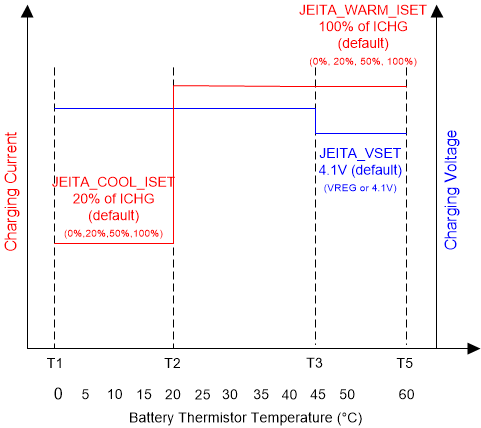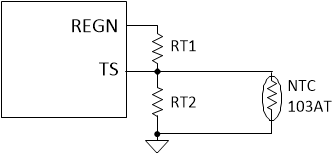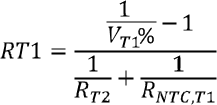ZHCSJZ6D June 2019 – December 2021 BQ25618 , BQ25619
PRODUCTION DATA
- 1 特性
- 2 应用
- 3 说明
- 4 Revision History
- 5 说明(续)
- 6 Pin Configuration and Functions
- 7 Specifications
-
8 Detailed Description
- 8.1 Overview
- 8.2 Functional Block Diagram
- 8.3
Feature Description
- 8.3.1 Power-On-Reset (POR)
- 8.3.2 Device Power Up From Battery Without Input Source
- 8.3.3 Power Up From Input Source
- 8.3.4 Boost Mode Operation From Battery
- 8.3.5 Power Path Management
- 8.3.6 Battery Charging Management
- 8.3.7 Ship Mode and QON Pin
- 8.3.8 Status Outputs (STAT, INT , PMID_GOOD)
- 8.3.9 Protections
- 8.3.10 Serial Interface
- 8.4 Device Functional Modes
- 8.5 Register Maps
- 9 Application and Implementation
- 10Power Supply Recommendations
- 11Layout
- 12Device and Documentation Support
- 13Mechanical, Packaging, and Orderable Information
8.3.6.4.1 JEITA Guideline Compliance During Charging Mode
To improve the safety of charging Li-ion batteries, the JEITA guideline was released on April 20, 2007. The guideline emphasized the importance of avoiding a high charge current and high charge voltage at certain low and high temperature ranges.
To initiate a charge cycle, the voltage on TS pin, as a percentage of VREGN, must be within the VT1_FALL% to VT5_RISE% thresholds. If the TS voltage percentage exceeds the T1-T5 range, the controller suspends charging, a TS fault is reported and waits until the battery temperature is within the T1-T5 range.
At cool temperature (T1-T2), the charge current is reduced to a programmable fast charge current (0%, 20% default, 50%, 100% of ICHG, by JEITA_ISET). At warm temperature (T3-T5), the charge voltage is reduced to 4.1 V or kept at VREG (JEITA_VSET), and the charge current can be reduced to a programmable level (0%, 20%, 50%, 100% default). Battery termination is disabled in T3-T5. The charger provides more flexible settings on a T2 and T3 threshold as well to program the temperature profile beyond JEITA. When T1 is set to 0°C and T5 is set to 60°C, T2 can be programmed to 5.5°C/10°C (default)/15°C/20°C, and T3 can be programmed to 40°C/45.5°C (default)/50.5°C/54.5°C.
When the charger does not need to monitor the NTC, the host sets the TS_IGNORE bit to 1 to ignore the TS pin condition during charging and Boost mode. If the TS_IGNORE bit is set to 1, the TS pin is ignored and the charger ignores the TS pin input. In this case, the NTC_FAULT bits are 000 to report normal TS status.
 Figure 8-4 JEITA
Profile
Figure 8-4 JEITA
Profile
Equation 1 through Equation 2 describe how to calculate resistor divider
values on the TS pin.
 Figure 8-5 TS Pin Resistor Network
Figure 8-5 TS Pin Resistor Network

In the equations above, RNTC, T1 is the NTC thermistor resistance value at temperature T1 and RNTC, T5 is the NTC thermistor resistance value at temperature T5. Selecting a 0°C to 60°C range for a Li-ion or Li-polymer battery then:
- RNTC,T1 = 27.28 kΩ (0°C)
- RNTC,T5 = 3.02 kΩ (60°C)
- RT1 = 5.3 kΩ
- RT2 = 31.14 kΩ